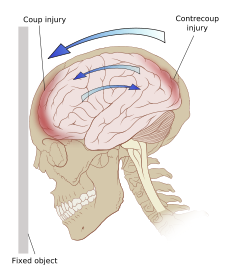
In head injury, a coup injury occurs under the site of impact with an object, and a contrecoup injury occurs on the side opposite the area that was hit.[1] Coup and contrecoup injuries are associated with cerebral contusions,[2] a type of traumatic brain injury in which the brain is bruised. Coup and contrecoup injuries can occur individually or together. When a moving object impacts the stationary head, coup injuries are typical,[3] while contrecoup injuries are produced when the moving head strikes a stationary object.[1]
Coup and contrecoup injuries are considered focal brain injuries – those that occur in a particular spot in the brain – as opposed to diffuse injuries, which occur over a more widespread area.[4] Diffuse axonal injury is the most prevalent pathology of coup contrecoup.[5]
The exact mechanism for the injuries, especially contrecoup injuries, is a subject of much debate.[6] In general, they involve an abrupt deceleration of the head, causing the brain to collide with the inside of the skull. It is likely that inertia is involved in the injuries, e.g. when the brain keeps moving after the skull is stopped by a fixed object or when the brain remains still after the skull is accelerated by an impact with a moving object.[6] Additionally, increased intracranial pressure and movement of cerebrospinal fluid following a trauma may play a role in the injury.[6][7]
- ^ a b Poirier MP (2003). "Concussions: Assessment, management, and recommendations for return to activity". Clinical Pediatric Emergency Medicine. 4 (3): 179–185. doi:10.1016/S1522-8401(03)00061-2.
- ^ Lury K, Castillo M (2004). "Lens dislocation: An unusual form of contrecoup injury". American Journal of Roentgenology. 183 (1): 250–251. doi:10.2214/ajr.183.1.1830250. PMID 15208154.
- ^ Morrison AL, King TM, Korell MA, Smialek JE, Troncoso JC (1998). "Acceleration-deceleration injuries to the brain in blunt force trauma". American Journal of Forensic Medicine and Pathology. 19 (2): 109–112. doi:10.1097/00000433-199806000-00002. PMID 9662103.
- ^ Hardman JM, Manoukian A (2002). "Pathology of head trauma". Neuroimaging Clinics of North America. 12 (2): 175–187, vii. doi:10.1016/S1052-5149(02)00009-6. PMID 12391630.
- ^ Johnson, V. E; Stewart, W; Smith, D. H (2012). "Axonal Pathology in Traumatic Brain Injury". Experimental Neurology. 246: 35–43. doi:10.1016/j.expneurol.2012.01.013. PMC 3979341. PMID 22285252.
- ^ a b c Shaw NA (2002). "The neurophysiology of concussion". Progress in Neurobiology. 67 (4): 281–344. doi:10.1016/S0301-0082(02)00018-7. PMID 12207973. S2CID 46514293.
- ^ McKee, A. C; Daneshvar, D. H (2015). "The neuropathology of traumatic brain injury". Traumatic Brain Injury, Part I. Handbook of Clinical Neurology. Vol. 127. pp. 45–66. doi:10.1016/B978-0-444-52892-6.00004-0. ISBN 9780444528926. PMC 4694720. PMID 25702209.